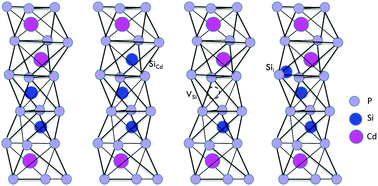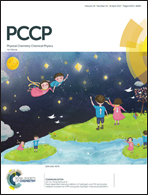Intrinsic defects and their effects on the optical properties in the nonlinear optical crystal CdSiP2: a first-principles study†
Abstract
In view of their high nonlinear optical coefficients and good phase-matching properties, CdSiP2 (CSP) crystals are considered as one of the most promising materials in the field of nonlinear optical applications. However, the slight absorption losses around 1.34 μm and 1.78 μm under e-polarized light have been affecting its performance. In this study, first-principles calculations were performed to identify the effects of various charge defects on the absorption properties. Different intrinsic defects in the CSP crystal were calculated using the HSE method and compared according to the specific chemical environments in the experiments. The results show that the point defects of V2−Cd, Si2+Cd, and V4−Si, which can be spontaneously formed, are dominant in the Cd-poor environment. The combination of Si2+Cd and V2−Cd defects is the most favorable cluster in the Cd-poor case because of its relatively low formation energy. Furthermore, the antisite defect SiCd was found to be responsible for the main absorption peaks at 1.34 and 1.78 μm in the experimental spectra, whereas other defects and clusters, such as the defects Si2+Cd and V0Si, also contribute to these red shifted absorptions. Our results intend to provide a guideline for adjusting the optical absorption in CSP by modifying its defects.



 Please wait while we load your content...
Please wait while we load your content...